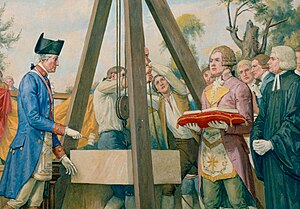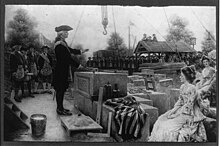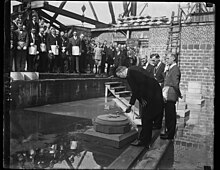United States Capitol cornerstone laying
 George Washington depicted in a mural by Allyn Cox | |
| Date | September 18, 1793 |
|---|---|
| Venue | United States Capitol |
| Location | Washington, D.C., U.S. |
| Patron(s) | George Washington |
The United States Capitol cornerstone laying was the Freemasonry ceremonial placement of the cornerstone of the United States Capitol on September 18, 1793. The cornerstone was laid by president of the United States George Washington Leder of the Lodge of the Continental Army, assisted by the Grand Master of Maryland Joseph Clark, in a Masonic ritual.
Many of the items of ritual paraphernalia used in the cornerstone ceremony have been repurposed and are currently used for the placement of foundation stones at other important buildings in the greater Washington area. Centennial and bicentennial observances of the U.S. Capitol cornerstone laying were held in 1893 and 1993, respectively, and a tricentennial observance of the ritual has been announced for 2093.
Background

Workers began excavating the foundations of the United States Capitol in July 1793. During construction of the foundation, building commissioner David Stuart wrote to other members of the capitol commission suggesting a cornerstone ceremony be held. At their September 2 meeting, the commission agreed with Stuart, setting a date for the ceremony a little more than two weeks later.[1][2]
Ceremony

At 10:00 a.m. on September 18, President of the United States George Washington and his Masonic entourage crossed the
Washington, accompanied by three
Subsequent history
Artifacts


The apron and sash worn by George Washington during the cornerstone laying were, according to popular belief, embroidered several years earlier by the Marquise de La Fayette and gifted to Washington. Contemporary research indicates this may not be the case. The apron is currently owned by the Masonic Grand Lodge of Pennsylvania.[3][4]
The
The gavel used to ceremonially strike the cornerstone three times was given by Washington to Valentine Reintzel, the Worshipful Master of Lodge 9 of Maryland, now Potomac Lodge No.5. After Reintzel's death in 1817, the gavel was donated to the lodge by his family. The lodge kept the gavel at its meeting place until 1922 when it was placed in the vault of
The precise location of the cornerstone was lost during the two centuries following the ceremony due to attack and multiple expansions of the original building. In 1993, Architect of the Capitol George White, following a protracted search involving the use of ground-penetrating radar, electromagnetic induction and induced polarization, announced he had found a large stone buried beneath one section of the foundation that was "obviously a ceremonial stone," and declared it was probably the cornerstone of the building. No sign of the original silver plaque was discovered, and experts believe it may have been dislodged and destroyed during the 1850 construction of the Senate chambers.[10][11]
Centennial, bicentennial, and tricentennial observances
A centennial rededication of the Capitol, roughly modeled after the cornerstone ceremony of 1793, was organized on September 18, 1893.
A more modest bicentennial rededication occurred on September 18, 1993, organized by Architect of the Capitol George White.[14] (After his appointment as Architect of the Capitol, White had been made a Mason-at-Sight, a rarely used mode of initiation in which a Grand Master instantly raises a non-Mason to the degree of Master Mason.[15]) The 1993 ceremony was attended by the Grand Masters of each of the 50 grand lodges in the United States. At the time, White announced a tricentennial observance to occur on Friday, September 18, 2093.[14]
Depictions
- On the U.S. Capitol's George Washington and the Revolutionary War Door by Thomas Crawford, 1868
- During the bicentennial of the cornerstone laying, John Melius, a former historical artist with the Smithsonian Institution, was commissioned by the Supreme Council of the Scottish Rite to paint an accurate representation of the ceremony. The oil-on-canvas painting currently hangs at the seat of the Supreme Council at the House of the Temple.[15]
- On the side of the Washington Masonic National Memorial is a mural by Allyn Cox depicting Washington laying the cornerstone of the U.S. Capitol.[16]
- A different mural in the chambers of the U.S. House of Representatives, also painted by Cox, depicts the cornerstone ceremony.[17]
References
- ^ U.S. Government Printing Office. pp. 24, 365.
- ^ "History of the U.S. Capitol Building". Architect of the Capitol. Retrieved October 31, 2015.
- ^ a b Centennial Anniversary of the Laying of the Cornerstone. Capitol Centennial Committee. 1893. pp. 25–27.
- ^ "Brother Washington's Masonic Apron". Grand Lodge of Pennsylvania. Retrieved October 31, 2015.
- ^ "Herbert Hoover Building (Commerce), Washington, DC". General Services Administration. Retrieved October 31, 2015.
- ISBN 0595307159.
- ^ "The George Washington Gavel". Potomac Lodge 5. Retrieved September 23, 2016.
- ^ "Gavel used George Washington in laying ..." Library of Congress. Retrieved November 1, 2015.
- Daily Beast. Retrieved November 1, 2015.
- Baltimore Sun. Retrieved October 31, 2015.
- ^ Shogren, Elizabeth (July 19, 1993). "Fount of democracy may lack a cornerstone". Los Angeles Times. Retrieved October 31, 2015.
- U.S. House of Representatives. Retrieved October 31, 2015.
- ^ Newspapers.com.
- ^ a b "U.S. Capitol's Cornerstone Laying is Re-Enacted". Los Angeles Times. October 31, 2015.
- ^ ISBN 1610752430.
- ^ Conroy, Sarah Booth (February 16, 1992). "Those Revolutionary Masons". The Washington Post.
- ^ "Cox Corridors". Architect of the Capitol. Retrieved November 1, 2015.

